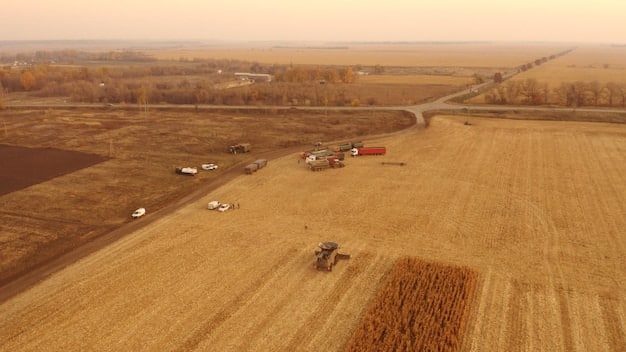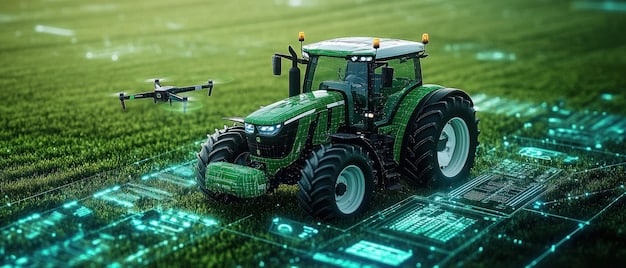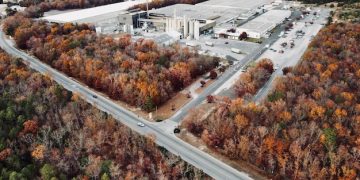US Agriculture Labor Crisis: Immigration and Tech Solutions

The US Agriculture Faces Labor Crisis: Exploring Solutions Through Immigration Reform and Technology is critical, with potential resolutions including immigration policy adjustments and embracing technological advancements to alleviate workforce shortages and ensure food supply stability.
The US Agriculture Faces Labor Crisis: Exploring Solutions Through Immigration Reform and Technology head-on, as shortages threaten food production and the economy. What are the innovative solutions to secure the future of American farming?
Understanding the US Agricultural Labor Crisis
The agricultural sector in the United States is currently grappling with a significant labor shortage. This shortage not only impacts crop yields and overall productivity, but also has far-reaching economic consequences. Understanding the complexities of this crisis is the first step towards identifying effective solutions.
Factors Contributing to the Labor Shortage
Several factors have converged to create the current labor crisis in US agriculture. These include declining interest in farm work among domestic workers, an aging agricultural workforce, and increasingly restrictive immigration policies.
- Declining Domestic Interest: Fewer Americans are choosing farm work due to its physically demanding nature and relatively low wages. This has created a gap that is traditionally filled by foreign-born workers.
- Aging Workforce: Many farmers and farmworkers are aging, leading to a gradual attrition of experienced labor. Attracting younger individuals to replace them has proven challenging.
- Restrictive Immigration Policies: Stricter immigration enforcement and policies have reduced the availability of foreign-born workers, who have historically been a crucial part of the agricultural labor force.

Understanding these factors is essential for crafting effective strategies to address the labor crisis. Without adequate labor, the agricultural sector risks decreased productivity, higher food prices, and a weakened rural economy.
The Role of Immigration Reform
Immigration reform is increasingly viewed as a critical component in addressing the agricultural labor crisis. Many propose that adapting immigration policies to better meet the needs of the agricultural sector can provide relief to struggling farmers and ensure a stable workforce.
Proposed Immigration Reforms
Several immigration reform proposals have been put forward to address the labor shortage in agriculture. These proposals often include provisions for temporary worker programs, pathways to legal status for undocumented workers, and streamlined visa processes.
- Expanding Temporary Worker Programs: Expanding programs like the H-2A visa program can provide a legal pathway for foreign-born workers to come to the US for seasonal agricultural work.
- Creating a Pathway to Legal Status: Offering a pathway to legal status for undocumented agricultural workers who are already working in the US can help retain experienced labor and provide stability for both workers and employers.
- Streamlining Visa Processes: Reducing bureaucratic hurdles and processing times for agricultural visas can ensure that farmers have access to the labor they need in a timely manner.
The effectiveness of immigration reform in resolving the labor crisis will depend on the specific provisions included in any new legislation. Policymakers must balance the needs of farmers with broader immigration concerns and ensure that any reforms are both practical and enforceable.
Technological Advancements in Agriculture
Technological advancements are emerging as another key solution to the agricultural labor crisis. Investing in and adopting new technologies can reduce the reliance on manual labor, increase efficiency, and improve overall productivity in the agricultural sector.
Types of Agricultural Technology
A wide range of technologies are being developed and implemented in agriculture, from automated machinery to precision farming techniques. These technologies can help farmers do more with less labor, addressing the workforce shortage while also improving sustainability.
One critical area is the development of automated harvesting systems. These machines can pick fruits and vegetables with minimal human intervention, significantly reducing the need for manual labor during harvest season. Another area of focus is precision farming. Precision farming involves using sensors, drones, and data analytics to optimize irrigation, fertilization, and pest control. By precisely targeting inputs, farmers can reduce waste and increase yields, all while requiring less labor.
Robotics is also transforming agriculture. Robots can perform tasks such as weeding, planting, and even livestock management. These robots can work around the clock, increasing efficiency and reducing the strain on human workers.
Case Studies: Successful Implementation of Solutions
Examining case studies where immigration reform and technology have been successfully implemented can provide valuable insights into what works and what doesn’t. Learning from these examples can help guide future policy decisions and investment strategies.
Immigration Reform Success Stories
In some regions, pilot programs and local initiatives have demonstrated the positive impact of immigration reform on agriculture. These programs often involve partnerships between farmers, community organizations, and government agencies to support foreign-born workers and address labor shortages.
For instance, certain states have implemented programs that provide legal assistance and education to undocumented agricultural workers. These programs help workers navigate the complex immigration system and gain legal status, ensuring a stable workforce for local farmers. Similarly, some communities have developed innovative approaches to housing and transportation for foreign-born workers, making it easier for them to come and work in the area.
Technology Adoption Success Stories
There are numerous examples of farms that have successfully adopted technology to address labor shortages and improve productivity. These farms often serve as models for others in the agricultural sector, demonstrating the potential of technology to transform farming practices.

These success stories highlight the importance of investing in research and development, providing training and support for farmers adopting new technologies, and fostering collaboration between technology developers and agricultural producers.
Challenges and Obstacles
Despite the potential benefits of immigration reform and technology, there are significant challenges and obstacles that must be addressed. Overcoming these challenges will require a concerted effort from policymakers, farmers, technology developers, and other stakeholders.
Challenges to Immigration Reform
Immigration reform faces political opposition and logistical hurdles. Finding common ground on immigration policy can be difficult, and even when reforms are enacted, implementation can be complex and time-consuming.
- Political Opposition: Immigration is a divisive issue, and any reform proposal is likely to face strong opposition from those who believe it is either too lenient or too restrictive.
- Bureaucratic Hurdles: The immigration system is often slow and inefficient, making it difficult for farmers to access the labor they need in a timely manner.
- Enforcement Concerns: Ensuring that immigration laws are enforced effectively is a major challenge, and any reform proposal must address this issue.
Challenges to Technology Adoption
Adopting new technologies can be costly and require significant investment in training and infrastructure. Many farmers may be hesitant to invest in technology due to financial constraints or a lack of technical expertise.
Many farmers, especially those in smaller operations, may lack the capital to invest in expensive new technologies. Additionally, some farmers may not have the technical skills needed to operate and maintain these technologies effectively. Overcoming these challenges will require financial assistance and technical support for farmers.
The Future of US Agriculture
The future of US agriculture depends on addressing the labor crisis through a combination of immigration reform and technology adoption. By embracing these solutions, the agricultural sector can ensure a stable workforce, improve productivity, and remain competitive in the global market.
The agricultural sector must embrace these changes to ensure productivity, sustainability, and competitiveness. By working together, policymakers, farmers, technology developers, and other stakeholders can build a vibrant and resilient agricultural sector that continues to feed the nation and the world.
| Key Point | Brief Description |
|---|---|
| 🧑🌾 Labor Shortage | US agriculture faces a critical shortage of farmworkers affecting productivity. |
| 🛂 Immigration Reform | Proposed reforms include expanding worker programs and creating pathways to legal status. |
| 🤖 Technology Adoption | Automation, precision farming, and robotics can reduce reliance on manual labor. |
| 🌱 Future Outlook | Combining immigration reform and technology is essential for a sustainable future. |
Frequently Asked Questions
▼
The main causes include declining interest in farm work among domestic workers, an aging agricultural workforce, and increasingly restrictive immigration policies that limit the availability of foreign-born labor.
▼
Immigration reform can expand temporary worker programs, create pathways to legal status for undocumented workers, and streamline visa processes, ensuring farmers have access to a stable and legal workforce.
▼
Technologies include automated harvesting systems, precision farming techniques using sensors and drones, and robotics for tasks like weeding, planting, and livestock management to improve efficiency and reduce labor strain.
▼
Challenges include the high cost of new technologies, the need for significant investment in training and infrastructure, and financial constraints faced by smaller farms that may lack the capital and technical expertise.
▼
Ensuring sustainability involves embracing immigration reform to secure a stable workforce and implementing technology to improve productivity and efficiency, thereby making the agricultural sector resilient and competitive.
Conclusion
Addressing the **US Agriculture Faces Labor Crisis: Exploring Solutions Through Immigration Reform and Technology** is crucial for the sustainability and growth of the agricultural sector. By strategically implementing immigration reforms and embracing technological advancements, the United States can ensure a stable workforce, increase productivity, and maintain its competitive edge in the global market, securing the future of American agriculture.





